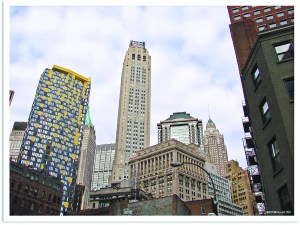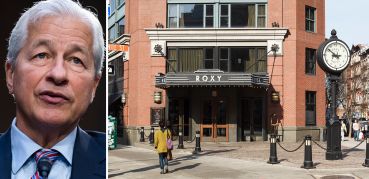Time to Change: Office Conversions, and Their Financings, Are Prevalent Downtown
By Eric Jankiewicz March 7, 2014 9:00 am
reprintsThe ongoing transformation of 20 Exchange Place from office to luxury rental apartments is only the latest change for the ever-morphing neighborhoods of lower Manhattan. Since the mid-’90s, development companies like Rose Associates and DTH Capital have been heavily investing in the area, often turning former office buildings, like the Art Deco skyscraper at 70 Pine Street, into residential or hospitality.

Rose Associates and DTH Capital borrowed $300 million to convert 70 Pine Street to a 700-unit residential building, and construction is currently underway there. Three banks loaned on the financing—the Bank of New York, M&T Bank and J.P. Morgan Chase.
“There is a huge amount of activity happening here,” Andrew Singer, the chairman and chief executive officer of the Singer & Bassuk Organization, told Mortgage Observer. “You have a healthy, thriving, rental residential market.” Singer & Bassuk have arranged financing for the completion of over 12,000 residential units in the area since 1995. Mr. Singer helped broker the conversion financing for the project, which garnered a nomination for REBNY’s Ingenious Deal of the Year Awards. Winners will be announced May 6.
One impetus for transforming office buildings in lower Manhattan was the implementation of the 421-g Tax Incentive program. Also known as Lower Manhattan Conversion Program, it exempted real estate tax on buildings that were being converted from commercial to residential. Other benefits included the fact that construction didn’t have to be completed in one year and that there is a 12-year exemption from real estate tax increases and 14-year abatement of “about 80 percent of the real estate taxes paid on the property before conversion,” according to public documents. However, the tax incentive expired in 2006.
One building Mr. Singer worked on during the mid-’90s was 45 Wall Street, a building he describes as being part of the “extremely old office stock” in lower Manhattan. Since then, the building was purchased for more than $134 million by the real estate agency TF Cornerstone, according to public records. The agency took a mortgage from Wachovia Multifamily Capital, originated for Fannie Mae.
The population in lower Manhattan has skyrocketed over the years, and development companies like Rose Associates, TF Cornerstone and DTH Capital have been on the forefront of accommodating the population increase. In the 1990s, lower Manhattan’s population was 13,675, according to statistics put together by the Downtown Alliance. The lower Manhattan area now has almost 41,000 residential housing units and is expected to continue to increase, according to a research report by Cushman & Wakefield.
“These old commercial buildings make great apartments,” Nicole Kolinsky, a representative for the Downtown Alliance, said. “There are these insanely beautiful penthouses that used to be offices. It sounds like somewhere Bruce Wayne would live.” The alliance defines lower Manhattan as everything Chambers Street and below, Ms. Kolinsky said. However, others set Canal Street as the demarcation line.
Many of the office buildings that developers purchased during the beginning of the tax program, which was implemented in 1996 and expired in 2006, were abandoned. The industry of turning office space into residential spaces has since become more aggressive and carnivorous. Ben Shaoul’s Magnum Real Estate recently purchased the top 21 floors at 140 West Street from Verizon. Magnum bought those floors for $274 million, according to public records.
When lower Manhattan first began changing from a commercial neighborhood to a more residential area, people were attracted to the relatively cheap rent of the new apartment buildings.
“It became a lower class alternative to other areas like the Upper East Side,” Mr. Singer said.
The area is no longer a cheap alternative, but in comparison to areas further north, lower Manhattan’s average rent price of $60 per square foot is still more affordable than other areas. According to the Cushman & Wakefield study, the average annual household income for lower Manhattan is $158,800, more than enough to cover rent prices that can range between $4,000 for a two-bedroom apartment to $2,000 for a one-bedroom.
Along with a population increase, tourists are visiting the area in large droves. According to a Downtown Alliance study, there are an estimated 11.5 million tourists going through lower Manhattan every year, many of whom choose to stay at a hotel in the same area. And the development world has been keen on satisfying this demand.
The development group Hakimian Organization bought the 35-story office building at 75 Wall Street in 2007 for more than $375 million. The building once served as the headquarters for the Barclays Bank. The bottom levels have been turned into the Andaz Hotel with 253 keys, while the upper levels now hold 354 condominiums and there’s also a garage.
“The 421-g tax abatement was definitely attractive to us, and it’s just as compelling from the homeowner’s perspective,” Shawn Hakimian, the vice president and director of marketing and sales at the Hakimian Organization, said via email. But he added that the sense that lower Manhattan was on the verge of something big helped pique interest as well.
“The Hakimian Organization and its partners purchased 75 Wall in 2006, because we saw immense potential in the Financial District and in that particular property,” Mr. Hakimian said. “At the time, Downtown Manhattan was buzzing with activity, from the many residential developments and conversion projects to all of the new hotels, boutiques and restaurants opening up, and we knew the Financial District was next.”
Even though the tax incentive has expired, development continues. In 2014 alone, nine hotels have opened all over the tiny sliver on the bottom of Manhattan Island, according to the Cushman & Wakefield study. Together, lower Manhattan has more than 4,100 hotel rooms. And in more recent years, as conversion has begun to slow down after hitting a climax in 2008, the activity of new construction projects has continued.
Buildings like the one at 70 Pine Street, in which AIG once had offices, used to represent New York City’s dominant finance industry. But the neighborhoods have now become more residential, and the glass-domed observatory of 70 Pine Street has turned into a building amenity that the future tenants will be able to use once construction has been completed.
“It is the most spectacular view of New York,” Mr. Singer said.


